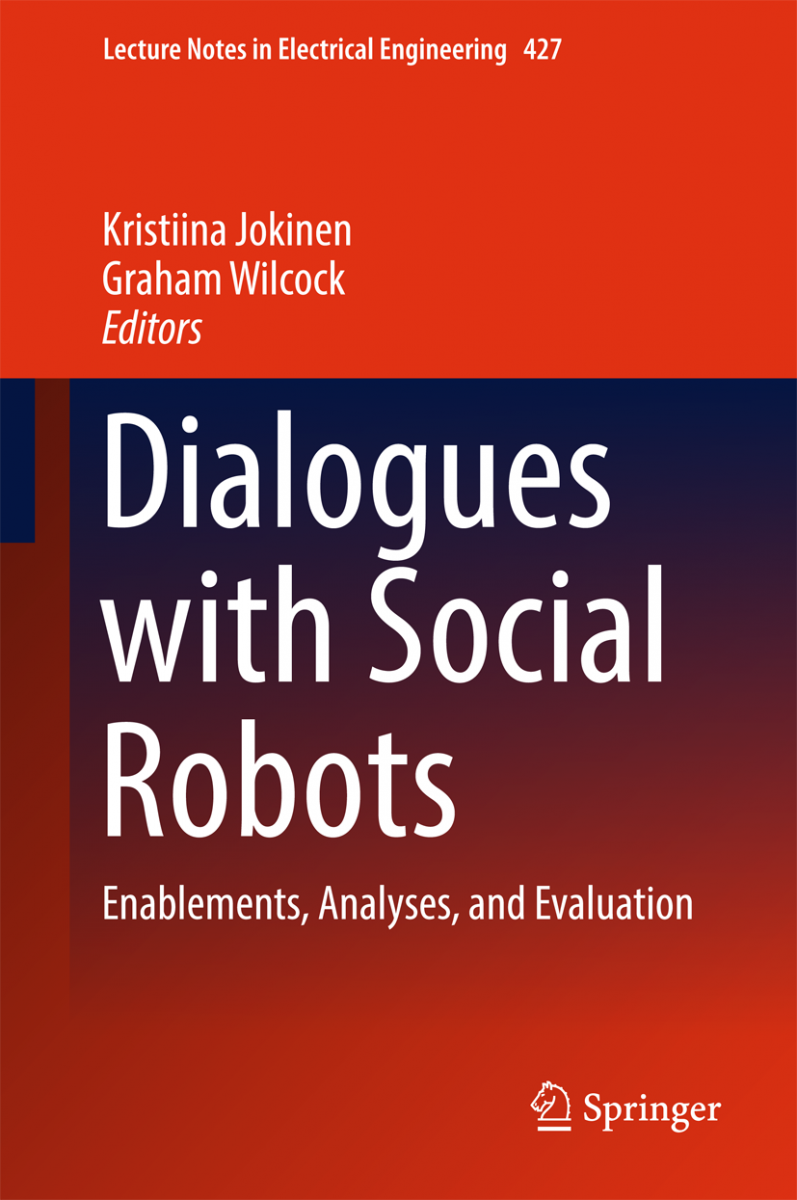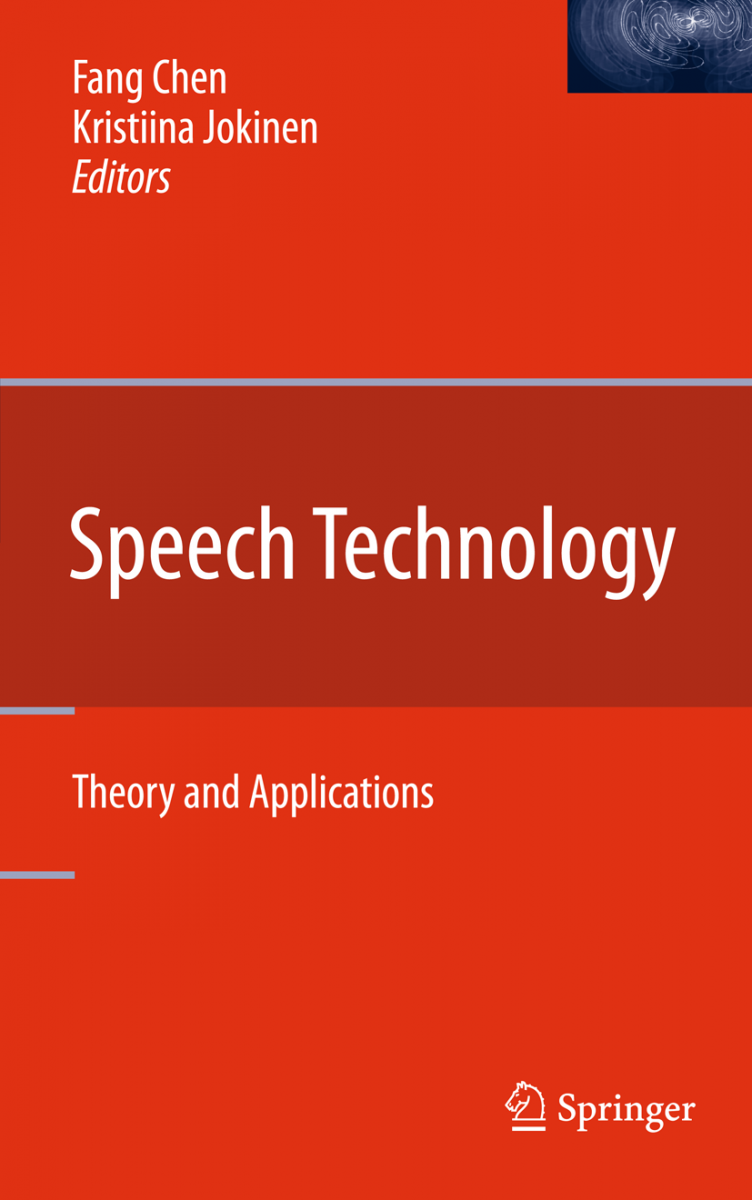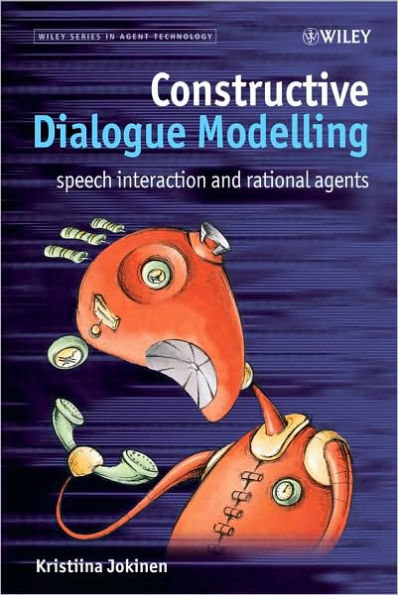
Jokinen, K. and Wilcock, G. (Eds). 2017.
Dialogues with Social Robots:
Enablements, Analyses, and Evaluation.
Lecture Notes in Electrical Engineering, Vol. 427.
Springer. ISBN 9789811025853.
This book explores novel aspects of social robotics, spoken dialogue systems, human-robot interaction, spoken language understanding, multimodal communication, and system evaluation. It offers a variety of perspectives on and solutions to the most important questions about advanced techniques for social robots and chat systems.
Chapters by leading researchers address key research and development topics in the field of spoken dialogue systems, focusing in particular on three special themes: dialogue state tracking, evaluation of human-robot dialogue in social robotics, and socio-cognitive language processing.
The book offers a valuable resource for researchers and practitioners in both academia and industry whose work involves advanced interaction technology and who are seeking an up-to-date overview of the key topics. It also provides supplementary educational material for courses on state-of-the-art dialogue system technologies, social robotics, and related research fields.

Chen, F. and Jokinen, K. (Eds). 2010.
Speech Technology:
Theory and Applications.
Springer. ISBN 9780387738185.
In recent years, spoken language research has successfully developed several practical applications, as well as brought forward advanced novel topics to investigate further. Speech Technology: Theory and Applications collects interesting research and development results and provides an overview of selected challenges still to be resolved. The book is organized along two main themes: research on enabling technology and applications that exemplify the use of this technology. Each chapter is an independent review of a specific topic, covering research problems and possible solutions. The basic technology development covers areas such as automatic speech recognition and speech synthesis, spoken dialogue systems and dialogue modeling, expressive speech synthesis, emotions and affective computing, multimodal communication and animated agents. The applications include speech translation, in-car, space, and military applications as well as those for special user groups. Discussion of general evaluation methodologies is also included. Speech Technology: Theory and Applications should be a useful reference for researchers, engineers and students in the field of speech technology.

Jokinen, K. and McTear, M. 2009.
Spoken Dialogue Systems.
Synthesis Lectures on Human Language Technologies.
Morgan & Claypool. ISBN 1598295993.
Considerable progress has been made in recent years in the development of dialogue systems that support robust and efficient human-machine interaction using spoken language. Spoken dialogue technology allows various interactive applications to be built and used for practical purposes, and research focuses on issues that aim to increase the system’s communicative competence by including aspects of error correction, cooperation, multimodality, and adaptation in context.
This book gives a comprehensive view of state-of-the-art techniques that are used to build spoken dialogue systems. It provides an overview of the basic issues such as system architectures, various dialogue management methods, system evaluation, and also surveys advanced topics concerning extensions of the basic model to more conversational setups.
The goal of the book is to provide an introduction to the methods, problems, and solutions that are used in dialogue system development and evaluation. It presents dialogue modelling and system development issues relevant in both academic and industrial environments and also discusses requirements and challenges for advanced interaction management and future research.

Jokinen, K. 2009.
Constructive Dialogue Modelling:
Speech Interaction and Rational Agents.
Wiley Series in Agent Technology.
John Wiley & Sons. ISBN 9780470060261.
Dialogue management technology has developed rapidly over the years resulting in real-time applications like telephony directories, timetable enquiries, and in-car applications. However, the current technology is still largely based on models that use rigid command language type interactions, and the users need to adapt their human communication strategies to the needs of the technology. As an increasing number of interactive ubiquitous applications will appear, challenges for interaction technology concern especially natural, more human-friendly communication. Recent research has focused on developing speech-based interactive systems that aim to increase the system’s communicative competence. By including aspects of interaction beyond simple speech recognition and question-answer based interaction, applications with more conversational interfaces have become possible. New dialogue management technology needs to address the challenges in human-technology interaction, so that smart environments should not only enable user-controlled command interfaces but equip applications with a capability that affords easy and friendly interactions with the user.
Dialogue Modelling: Speech Interaction and Rational Agents provides an overview of the current dialogue technology and research trends in spoken dialogue systems, presenting a coherent perspective of AI-based cooperative interaction management. The book complements existing research regarding human-computer interfaces, speech and language technology, and communication studies in general, bringing different view-points together and integrating them into a single point of reference.
